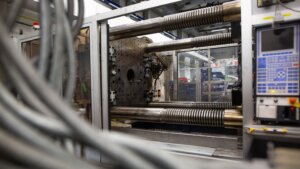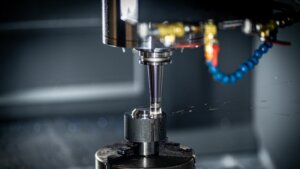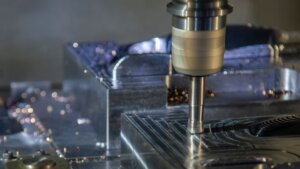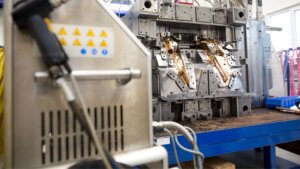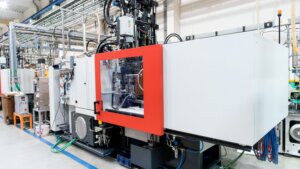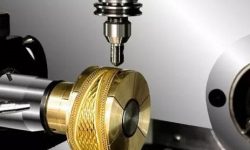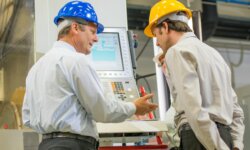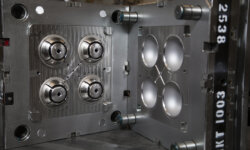The manufacturing world stands at a crossroads where precision meets innovation, particularly in the realms of Injection Molding and CNC Machining.
Injection Molding and CNC Machining, while seemingly similar, operate on fundamentally different principles. Injection Molding, akin to casting, molds molten materials into predefined shapes. CNC Machining, in contrast, subtracts material through cutting and drilling to achieve the desired form. These two processes, integral to modern manufacturing, serve diverse applications from consumer goods to intricate aerospace components.
This detailed exploration delves into the intricacies of these two manufacturing methods, dissecting their differences, advantages, and the technological advancements that shape their future.
What is the Difference Between CNC Machining and Injection Molding?
CNC Machining and Injection Molding differ primarily in their approach to shaping materials. While CNC Machining involves direct material removal through precise cutting, plastic injection molding relies on injecting molten material into molds. This fundamental difference dictates their respective strengths, applications, and efficiency.
What is CNC Machining?
CNC Machining stands for Computer Numerical Control Machining. It’s a process where pre-programmed computer software dictates the movement of factory tools and machinery. In its essence, CNC machining involves cutting from a block of material and enables the production of complex shapes that would be almost impossible to achieve with manual machining.
Key Components of CNC Machining
- Computer software: The brain behind the operation is the computer numerical control, translating designs into commands.
- Cutting tools: Various tools like end mills and drills, responsible for the material removal.
- Workpiece: The raw material block that is shaped into the final product.
How CNC Machining Works: A Step-by-Step Explanation
- Design Phase: Utilizing CAD (Computer-Aided Design) software to create the detailed design.
- Programming: Translating the CAD design into CNC language (G-code).
- Setup: Preparing the CNC machine with the appropriate tools and material.
- Machining: The machine executes the G-code, cutting and shaping the material.
- Finishing: Final touches and inspections to ensure quality and precision.
What is Injection Molding?
Injection Molding is a manufacturing method used for producing parts by injecting molten material into a mold, also known as tool. Injection molding produces parts for a variety of inddustries, from the smallest components to entire body panels of cars.
Key Components of Injection Molding are:
- Mold: The custom-designed cavity that shapes the part.
- Injection Unit: Heats and injects the material into the mold.
- Clamping Unit: Holds the mold closed during the injection process.
How Injection Molding Works: A Step-by-Step Explanation
- Mold Design: Creating a mold that reflects the desired part’s shape.
- Material Preparation: Heating the chosen material until it becomes molten.
- Injection: The molten material is injected into the mold cavity.
- Cooling: The material cools and solidifies in the shape of the cavity.
- Ejection: The solidified part is ejected from the mold.
What are the Advantages and Disadvantages of Each Process?
As we delve into their respective worlds, it’s crucial to understand not just their individual strengths and weaknesses, but also how they compare and contrast in various manufacturing scenarios.
This understanding is pivotal for anyone navigating the complex landscape of modern manufacturing processes.
Advantages of CNC Machining When Compared to Injection Molding
CNC Machining, a process characterized by its precision and flexibility, stands out in its ability to cater to complex and detailed designs. The advantages of this method, particularly when contrasted with Injection Molding, are manifold and cater to a broad range of manufacturing needs.
- Precision and Customization: CNC Machining thrives in scenarios demanding high precision and custom part design. Its ability to produce parts with tight tolerances and complex geometries is unparalleled.
- Material Versatility: From rigid materials like metals to flexible plastics, CNC Machining can handle a diverse array of materials, offering a broader range of applications.
- Design Flexibility: Unlike Injection Molding, which requires mold fabrication, CNC Machining allows for quick design changes without significant additional costs.
- Reduced Lead Time for Prototypes: CNC Machining is ideal for prototyping, offering a rapid turnaround time and the ability to produce high-quality parts without the need for extensive tooling.
- High-Quality Surface Finish: CNC Machined parts often require minimal post-processing, ensuring a high-quality finish that is often critical in industries like aerospace and medical devices.
Disadvantages of CNC Machining When Compared to Injection Molding
While CNC Machining shines in many aspects, it does have its limitations, especially when compared to the Injection Molding process. These disadvantages become particularly apparent in certain manufacturing contexts.
- Cost-Effectiveness for High Volumes: CNC Machining becomes less cost-effective in high-volume production compared to Injection Molding, which can produce large quantities more economically.
- Material Waste: The subtractive nature of CNC Machining, where material is removed, leads to higher waste compared to the additive nature of Injection Molding.
- Energy Consumption: CNC Machines generally consume more energy per unit of production, especially when compared to the efficiency of Injection Molding machines in large-scale production.
- Production Speed for Large Volumes: In terms of production speed for large volumes, CNC Machining lags behind Injection Molding, which can churn out high volumes at a much more rapid pace.
- Limitation in Producing Extremely Intricate Internal Features: While CNC Machining is excellent for complex external geometries, it can be limited in creating extremely intricate internal features due to tool access issues.
Advantages of Injection Molding When Compared to CNC Machining
Injection Molding, known for its efficiency in high-volume parts production, offers a range of benefits, especially when compared to CNC Machining. This process is particularly advantageous in scenarios where the production of large quantities of plastic parts is required.
- High Volume Efficiency: Injection Molding is unbeatable in its ability to produce large quantities of parts at a rapid pace, making it a cost-effective choice for mass production.
- Complex Part Production: This process allows for the creation of complex geometries and intricate designs that might be challenging or impossible to achieve through CNC Machining.
- Consistency and Reproducibility: Injection Molding ensures high repeatability, producing parts that are consistent in quality and appearance, crucial for large production runs.
- Reduced Labor Costs: Automation in Injection Molding reduces the need for labor, lowering production costs significantly, especially in large-scale operations.
- Material Efficiency: The process minimizes material waste as excess material can often be recycled, making it a more sustainable choice for manufacturing plastic parts.
Disadvantages of Injection Molding When Compared to CNC Machining
Despite its numerous advantages, Injection Molding also presents certain limitations, particularly when assessed alongside CNC Machining. Understanding these drawbacks is essential for manufacturers to make informed decisions.
- Upfront Investment: The initial cost of creating injection molds can be high, especially for custom designs, making Injection Molding less viable for small production runs.
- Limited Material Choice: While Injection Molding is ideal for plastics, rubber and other flexible materials, its application is limited with materials that cannot be heated and injected.
- Longer Lead Times for Mold Creation: The time required to design and fabricate molds can extend the overall production timeline, especially when compared to the direct start of CNC Machining.
- Design Restrictions: Despite its ability to produce complex shapes, certain design constraints exist, such as the need for uniform wall thickness to prevent defects.
- Difficulty in Making Design Changes: Once an injection mold is made, making design modifications can be costly and time-consuming, unlike the flexibility offered by CNC Machining.
How Do Injection Molding and CNC Machining Compare in Detail?
In the comparison below we aim to dissect and understand these methods, not just in isolation but in their contrasting capabilities and limitations across various factors.
Design Geometry and Limitations
Injection Molding excels in creating complex, intricate designs, especially useful for parts with internal cavities or detailed surface textures. This process can produce parts with consistent geometries at high volumes, albeit with some design limitations such as uniform wall thickness to prevent warping or sink marks.
On the other hand, CNC Machining offers unparalleled flexibility in design geometry. It can produce parts with intricate details and complex external geometries. However, it faces limitations with internal features, as the cutting tools must be able to access these areas. CNC Machining is also constrained by the size of the raw material block and the movement range of the machining apparatus.
Strength and Performance
When evaluating strength and performance, both Injection Molding and CNC Machining bring distinct advantages to the table.
Injection Molding, especially with plastic injection molding, allows for the creation of parts with uniform mechanical properties and strength. This process is well-suited for producing parts that need to withstand stress and strain uniformly across their surface. Additionally, the range of plastic materials available for Injection Molding, including high-performance plastics, provides options for varying strength requirements.
CNC Machining, conversely, is known for its ability to work with a broader range of materials, including metals, plastics, and even wood. The strength and performance of CNC machined parts are highly dependent on the chosen material. Machined parts are often stronger than molded parts, especially when using metals, due to the nature of the material and the lack of stress introduced during the manufacturing process.
Tolerances
The tolerances achievable in manufacturing processes are critical, especially in industries requiring high precision, such as aerospace and medical devices. Injection Molding can achieve tolerances within the range of ±0.500 mm (±0.020 inches). This level of precision is suitable for many applications but may not suffice for parts requiring ultra-high precision.
CNC Machining, in contrast, is renowned for its exceptional precision and can typically achieve standard tolerances as tight as ±0.127 mm (±0.005 inches). This high degree of accuracy is due to the controlled nature of the cutting process and the advanced technology of CNC machines. This level of accuracy makes precision CNC Machining the commonly preferred choice for parts where tight tolerances are crucial.
Cycles and Efficiency
The cycle time and efficiency of a manufacturing process are crucial in determining its suitability for a project.
Injection Molding is known for its fast cycle times, especially once the molds are created. This efficiency makes it ideal for high-volume production where thousands or even millions of parts are required. The cycle times can be as short as a few seconds, depending on the complexity and size of the part.
CNC Machining, conversely, has longer cycle times. Each part requires individualized cutting and shaping, making the process inherently more expensive and slower. However, CNC Machining excels in precision and flexibility, suitable for complex designs where each part might be different or require fine detailing.
Upfront Investment
The upfront cost for both processes varies significantly.
Injection Molding typically requires a higher initial investment, mainly due to the cost of designing and creating molds. This cost can be substantial, especially for complex parts. However, once the molds are made, the cost per part decreases significantly, making it cost-effective for large production runs.
CNC Machining, in contrast, has a lower upfront investment. The cost is primarily associated with setting up the CNC machine and material costs. This makes CNC Machining more accessible for small to medium-sized production runs and for projects where the design might change over time.
Volume and Scale of Production
When it comes to the volume and scale of production, each process has its ideal use case.
Injection Molding is the preferred method for high-volume production. Its ability to produce large numbers of parts quickly and consistently makes it cost-effective option for mass production.
CNC Machining is better suited for low to medium volume production. Its flexibility and precision make it ideal for customized or intricate designs where each part might be unique.
The cost per part for CNC Machining does not decrease as significantly with volume as it does with Injection Molding, making it less cost-effective for very high volumes.
Design Flexibility and Complexity
Design flexibility and complexity are critical factors in choosing between Injection Molding and CNC Machining.
Injection Molding offers limited design flexibility once the mold is created. Making changes to the design can be costly and time-consuming as it might require creating a new mold. However, it can produce complex shapes, especially beneficial for parts with internal cavities or intricate surface details.
CNC Machining offers greater design flexibility. Changes can be made relatively easily, as they typically only require modifying the CAD file and machine programming. CNC Machining can produce highly complex designs, including parts with varying depths and intricate details, which might be challenging to achieve with Injection Molding.
Lead Time and Speed
Lead time and speed are crucial factors in manufacturing, affecting the overall efficiency and turnaround time of production.
- Injection Molding: Typically, the lead time for Injection Molding can range from 2 to 6 weeks, including the time required to create molds. Once the molds are prepared, the production speed is notably fast, with cycles ranging from a few seconds to minutes per part, depending on the complexity and size of the molded item.
- CNC Machining: CNC Machining lead times can be shorter, often within 1-2 weeks, as it does not require tooling setup like mold creation. However, the production speed is slower compared to Injection Molding, as each part is individually machined. Speed varies significantly based on the complexity of the part, but on average, CNC Machining can produce parts at a rate of several hours per piece.
Cost-effectiveness
Cost-effectiveness in manufacturing is evaluated based on the average cost per part, considering material, labor, and overhead costs.
- Injection Molding: The cost-effectiveness of Injection Molding increases significantly with volume. For high-volume production, the average cost per part can be as low as a few cents to a dollar, predominantly due to the low operational cost once the molds are created.
- CNC Machining: In contrast, the cost per part in CNC Machining is generally higher than that in other manufacturing processes, especially for low-volume production. On average, the cost can range from several dollars to tens of dollars per part, depending on the material used and the complexity of the part.
Energy Consumption and Efficiency
Energy consumption and efficiency are important considerations in terms of operational cost and environmental impact.
- Injection Molding: Injection Molding machines typically consume around 4 to 6 kWh per hour. However, the overall energy efficiency is high, especially in mass production, due to the fast cycle times and the ability to produce large quantities quickly.
- CNC Machining: CNC machines, particularly for heavy-duty operations, can consume between 15 to 20 kWh per hour. While individual machines vary, CNC Machining is generally less energy efficient compared to Injection Molding, primarily due to longer production times for each part.
Material Suitability and Availability
The range of materials suitable for a manufacturing process is a key factor in its versatility and application in different industries.
- Injection Molding: This process is predominantly used for softer materials likes plastics, including a wide variety of thermoplastics and thermosetting plastics. The availability of diverse plastic materials makes Injection Molding highly versatile for producing parts in industries ranging from consumer products to automotive and medical devices.
- CNC Machining: CNC Machining supports a wider range of material types, including metals (such as aluminum, steel, brass), plastics, and even wood. This wide material compatibility makes CNC Machining extremely versatile for applications requiring raw materials with different properties, from aerospace components to custom machinery parts.
Environmental Considerations and Sustainability
The environmental impact of these processes is increasingly important in today’s manufacturing decisions.
- Material Waste:
- Injection Molding: Generates minimal waste as excess material can often be recycled. However, the production of plastic molds and the potential for plastic waste remain environmental concerns.
- CNC Machining: Typically produces more waste due to its subtractive nature. The material removed during machining often ends up as scrap, although recycling initiatives can mitigate this impact.
Safety Considerations
Injection Molding is generally considered safer due to the enclosed nature of the process. However, high temperatures used in melting materials and the pressure involved in injection can pose risks.
CNC Machining requires more safety considerations due to the involvement of cutting tools and high-speed machinery. The risk of injury from sharp tools and flying debris makes it more dangerous for operators, necessitating strict safety protocols and training.
Tooling Longevity and Maintenance Requirements
The longevity and maintenance of tools directly impact the cost and efficiency of manufacturing processes.
- Injection Molding: Mold longevity varies based on the material and complexity but can range from 100,000 to 1,000,000 cycles. Regular maintenance is required to ensure mold quality, involving cleaning and repairs.
- CNC Machining: Tooling in CNC Machining (like end mills and drill bits) generally has a shorter lifespan compared to injection molds, often requiring replacement after a few thousand cycles. However, maintenance is relatively straightforward, primarily involving tool changes and machine calibration.
What are the Similarities Between CNC Machining and Injection Molding?
While CNC Machining and Injection Molding are often viewed through the lens of their differences, they share several key similarities that are fundamental to the manufacturing process.
- Precision in Manufacturing: Both CNC Machining and Injection Molding are known for their ability to produce parts with high precision. They are designed to meet specific design specifications with great accuracy, which is critical in industries where the dimensions and tolerances of parts are crucial.
- Design Iterations and Development: Both processes allow for iterative design development. While CNC Machining offers more flexibility for changes in design, Injection Molding, through rapid tooling, can also accommodate design modifications, albeit at a higher cost and longer lead times.
- Complex Part Production: Each method can produce complex parts, albeit through different approaches. CNC Machining achieves complexity through subtractive methods, allowing for intricate designs and geometries. Injection Molding, on the other hand, can create complex shapes through mold designs.
- Use in Diverse Industries: Both techniques are employed across a broad spectrum of industries. From automotive to medical devices, aerospace to consumer goods, CNC Machining and Injection Molding have wide applications due to their versatility and precision.
Conclusion
CNC Machining and Injection Molding are distinct yet integral manufacturing methods, each with unique advantages and challenges.
CNC Machining stands out for its precision, flexibility, and suitability for a wide range of materials, making it ideal for low to medium volume production of complex parts.
Injection Molding, with its efficiency in high-volume production and consistency in part quality, excels in the mass production of plastic parts. The choice between these two methods largely depends on production volume, material requirements, part complexity, and cost considerations.
3ERP excels in both Injection Molding and CNC Machining processes.
Our injection molding services include high-quality prototype moldings from rapid tooling in aluminum or soft steel, with turnaround times as little as 7 days. We specialize in parts with challenges like tight tolerances, thin walls, and complex geometries.
For CNC Machining services, our two factories house over 60 CNC machines, supported by a vast network across China, Mexico, Germany, and the US. This extensive capacity ensures on-time delivery of high-quality machined parts, catering to diverse prototyping and production part machining needs.
FAQs
Is injection molding cheaper than CNC machining?
Generally, Injection Molding tends to be more cost-effective than CNC Machining for large production volumes due to economies of scale and faster production rates. The initial high cost of mold creation in Injection Molding is offset by the lower per-unit cost in high-volume production. In contrast, CNC Machining, while offering more flexibility and lower upfront costs, typically has a higher per-unit cost, particularly for small batches or complex parts.


